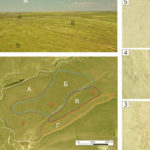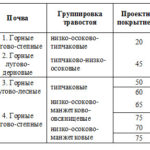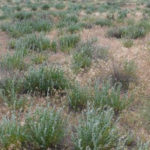UDC 581.527.2; 581.527.5
Safronova I.N., Stepanova N.Yu., Karimova T.Yu., Kalmykova O.G., Ulanova S.S., Fedorova N.L., Goryaev I.A., Polyektov S.A., Polyakov D.G. THE ACTUAL VEGETATION MAP FOR THE TERRITORY OF DISTRIBUTION OF SAIGA TATARICA TATARIC L. POPULATION IN THE NORTH-WESTERN CASPIAN REGION // Arid Ecosystems. 2023. Vol. 29. № 3 (96). P. 46-56. | PDF
The map of the current vegetation on the territory of the present and expected distribution of the saiga population in the North-Western Caspian region is presented. The map was created under an agreement with the World Wildlife Fund (WWF) at a scale of 1:200,000 in the ArcGIS. Its legend contains 61 numbers, combined into 11 groups according to the dominant formation. In the steppe zone, fallows and pastures of different ages on slightly undulating and undulating plains with light-brown soils (Kastanozem by WRB) are represented by Stipa sareptana, Artemisia lerchiana communities on loamy and sandy loam soils in complex with Artemisia lerchiana and Leymus ramosus, Poa bulbosa, Agropyron desertorum on solonetz (I); Stipa sareptana, S. lessingiana, Festuca valesiaca, Agropyron desertorum, Poa bulbosa, Artemisia lerchiana, Tanacetum achilleifolium communities on loamy and sandy loam soils in complex with Artemisia lerchiana, A. pauciflora, Tanacetum achilleifolium on solonetz (II); Festuca valesiaca, Agropyron desertorum, Stipa sareptana, Leymus ramosus, Artemisia lerchiana communities on loamy and sandy loam saline soils in complex with Artemisia lerchiana, A. pauciflora, Tanacetum achilleifolium, Poa bulbosa, Leymus ramosus on solonetz (III); Poa bulbosa, Agropyron desertorum, Stipa sareptana, Leymus ramosus, Artemisia lerchiana, A. taurica, Tanacetum achilleifolium communities on loamy and sandy loam saline soils in complex with Artemisia taurica, A. lerchiana, A. pauciflora on solonetz (IV); Artemisia lerchiana, A. austriaca, Festuca valesiaca, Agropyron desertorum, Leymus ramosus and Festuca valesiaca, Poa bulbosa, Artemisia austriaca communities on loamy and sandy loam saline soils in complex with Artemisia pauciflora, A. santonica on solonetz (V). In the desert zone, pastures on hilly sands, undulating plains with brown desert (Calcisol by WRB) sandy and sandy loam soils are represented by Artemisia lerchiana, Poa bulbosa and Poa bulbosa, Artemisia lerchiana communities (VI); Artemisia lerchiana, Poa bulbosa communities on brown desert saline soils of light granulometric composition in complexes with Artemisia pauciflora, Poa bulbosa on solonetz (VII); complexes of Artemisia lerchiana, Poa bulbosa and Artemisia taurica, Poa bulbosa communities on brown desert saline soils of light granulometric composition (VIII); complexes of Poa bulbosa, Artemisia lerchiana and Poa bulbosa, Artemisia taurica communities on brown desert saline soils of light granulometric composition (IX); Artemisia lerchiana, Poa bulbosa communities on undulating sands, Calligonum aphyllum on hilly sands (X); Poa bulbosa, Stipa sareptana, S. caspia, Agropyron fragile, Sporobolus cryptandrus, annual (Ceratocarpus arenarius, etc.) communities on intensive pastures with brown desert sandy soils (XI).
Keywords: vegetation map, modern vegetation cover, steppe zone, desert zone, fallows, pastures, saiga antelopes.
Financing. The work was carried out under the research agreement No. 1/71 (30/04/2021) of the V.L. Komarov Botanical Institute of the Russian Academy of Sciences with the World Wildlife Fund “Assessment of Saiga Habitats of the Northwestern Caspian Sea”; the grant of the Russian Foundation for Basic Research No. 15-05-06773 “Vegetation Cover of the Caspian Lowland in the System of Botanical and Geographical Zoning”; on the topic No. 121032500047-1 of the Laboratory of General Geobotany of the V.L. Komarov Botanical Institute “Vegetation of European Russia and Northern Asia: Diversity, Dynamics, Principles of Organization”; under the state task No. 122042700002-6 of the N.V. Tsitsin Main Botanical Garden of the Russian Academy of Sciences; on the topic of the Institute of the Steppe of the Ural Branch of the Russian Academy of Sciences No. AAAAA21-121011190016-1; on the topic of the state task No. AAAAA18-118042490055-7 (0089-2021-0010) of the A.N. Severtsov Institute of Ecology and Evolution of the Russian Academy of Sciences “Fundamental Problems of Wildlife Conservation and Rational Use of Biological Resources”; on the topic of fundamental research plsnned for 2022-2024 of the Water Problems Institute of the Russian Academy of Sciences “Research of Geoecological Processes in Hydrological Systems of Land, Formation of Surface and Groundwater Quality, Problems of Water Resources Management and Water Use in the Conditions of Climate Change and Anthropogenic Impacts” (No. FMWZ-2022-0002), State registration No. AAAA-A18-118022090104-8; on the topic of the state task of the Institute for Integrated Research of Arid Territories “Monitoring the Current State of Pasture Resources of the Republic of Kalmykia Using Geoinformation Systems”. It was also supported by the Ministry of Education and Science of the Central Research and Development Center “Herbarium of the Main Botanical Garden of the Russian Academy of Sciences” (No. 075-15-2021-67).
DOI: 10.24412/1993-3916-2023-3-46-56
EDN: QSGELU







